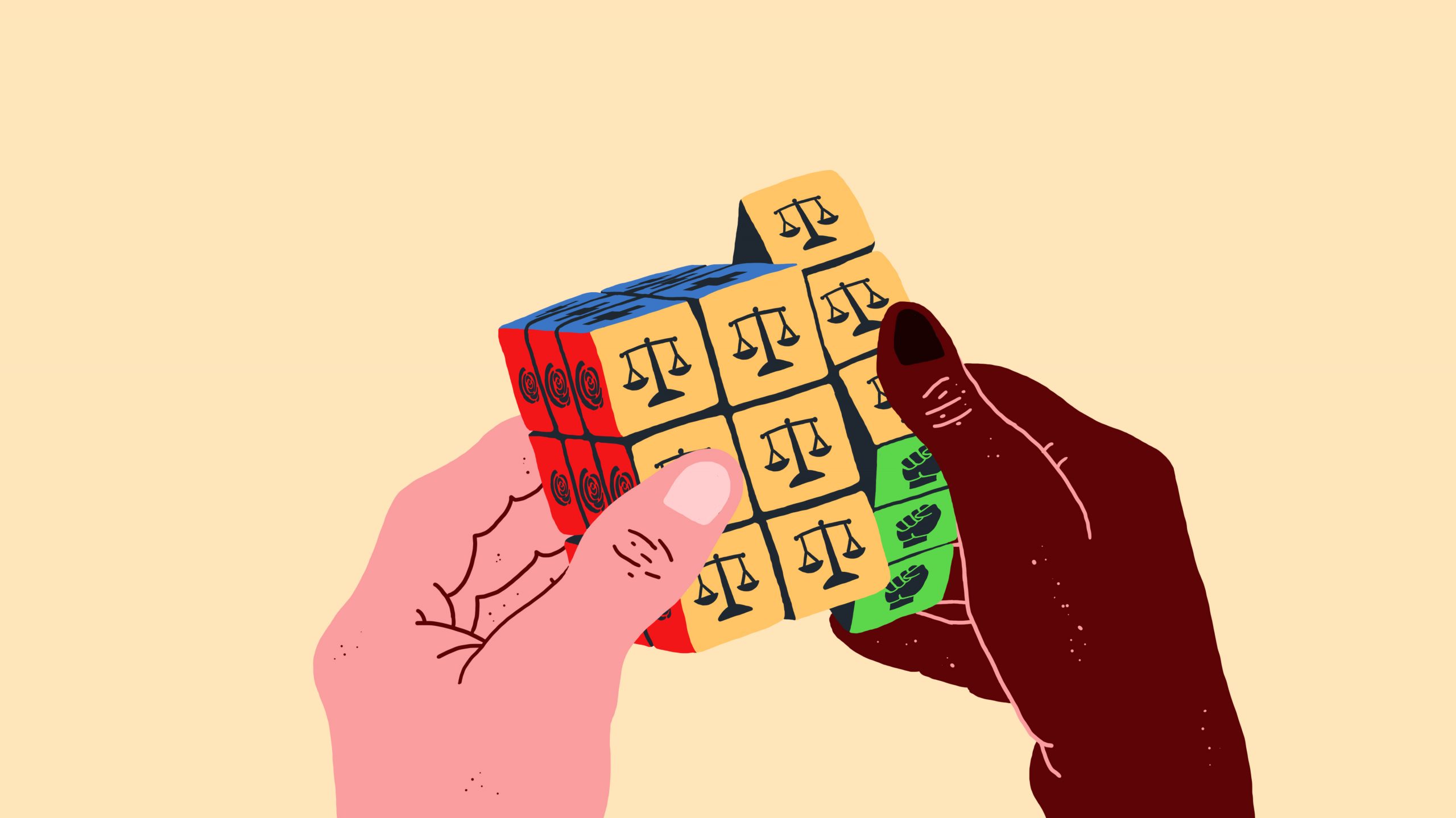Challenged to Solidarity: DSA After the Uprisings

Illustration by iggdeh
A year into the uprisings for Black lives, many predominantly white organizations, including DSA, are grappling with how best to engage in the struggle—being an “ally,” although a good start, is no longer enough. As commonly understood on the Left, “allyship” focuses on interpersonal interactions, such as checking white privilege, being aware of microaggressions, not dominating the conversation, and educating oneself about racism. The focus on white allies changing their hearts and minds often comes at the expense of collective action to change systems of oppression. For instance, posting a social media status about feelings of guilt is not the same as taking to the streets in solidarity with comrades of color.
Challenging white groups to go beyond allyship to a politics of solidarity, Khury Petersen-Smith and brian bean have put forth an analysis and critique of allyship. In one form, white anti-racists are urged to follow the lead of people of color, thereby effectively leaving the work of ending racism to people of color. In the second understanding, white allies are urged to use their privilege on behalf of people of color, thereby leaving people of color to receive passively the benefits of white allies’ white privilege. In both cases, one group becomes active participants and the other passive recipients. In contrast, solidarity occurs when all organizers do the work of making strategic decisions, building knowledge, and carrying out actions.
Jaime Grant defines allyship as virtue-signaling meant to show how aware of oppression the “ally” is. An example of this would be “Blackout Tuesday,” where celebrities, influencers, and corporations posted black squares to social media to show their support for Black Lives Matter. Although the original organizers claimed that the protest would continue beyond that Tuesday, there was no accompanying “ask” to these social media posts, such as donating to mutual aid and bail funds.
Ally work asks very little of allies. Often, allies have to deal only with the discomfort of acknowledging their privilege. As Andrea Smith writes in “The Problem with Privilege,” the task of anti-racist activists is to dismantle racist structures, a project that can’t be done by centering white allies’ behavior; instead, we need to challenge racist institutions such as housing, criminal justice, healthcare, and education.
There is broad agreement among DSA members that solidarity is the key to our growth and success. Many recognize that solidarity isn’t about papering over differences or striving for false unity. Solidarity is about acknowledging that our oppressions are connected and that the only true freedom is collective freedom.
Take, for example, the work of Metro DC DSA’s tenant organizing working group. In a report called “Getting Past the Door, How We Moved from Canvassing to Organizing Buildings,” the group openly addresses its lack of diversity. Noting that “we’re mostly operating in neighborhoods and buildings east of the Anacostia River where almost all tenants are Black and lower-income… We have been intentional about recruiting women and people of color to our volunteer organizing group, but, like the DSA as a whole, our group remains disproportionately white and male.” The report focuses on how the DSA organizers worked to organize through those differences. They did this by making connections with natural leaders within the buildings they sought to organize. They also shared vital information, such as pamphlets on tenants’ rights, legal aid contacts, and health clinics.
During last summer’s uprisings, the NYC DSA marshals known as the Red Rabbits shared trainings on street safety with DSA members and others. Red Rabbits also dispersed walkie talkies (which are not connected to the Internet) and megaphones around the city informally and then offered more formal help when the Defund the Police rallies began in early June. In this case, being in solidarity meant mobilizing support to respond to a dynamic moment.
In general, allyship is not about redistributing resources or dismantling structures and institutions. Solidarity can be about all of those, but above all, it is about taking action. Solidarity is about working in collaboration with marginalized people. In comparison, allies tend to focus on talking with and being educated by people of color.
Another way to think of solidarity is to think of oneself as a “co-conspirator.” BLM activist and cofounder Alicia Garza describes co-conspiracy as “what we do in action, not just in language… It is about moving through guilt and shame and recognizing that we did not create none of this stuff. And so what we are taking responsibility for is the power that we hold to transform our conditions.”
One example of radical solidarity involves the case of artist and activist Bree Newsome. Newsome came to fame for removing the Confederate flag outside the South Carolina Capitol building in 2015. Newsome, a Black woman, was aided by a white male named James Tyson, who stayed at the bottom of the pole to spot her. When police pointed their tasers at Newsome, Tyson embraced the base of the metal flagpole, joining in the danger to her of severe injury or even death. The officials withdrew their weapons. This is a model, Newsome said, of “how we see police escalate or de-escalate due to skin color.”
So, how can DSA members act in solidarity? As organizers, we must experiment to find what works. We can analyze both the successes and failures of socialists of the past.
The difference between DSA and white ally organizations is that DSA is committed to winning socialism for the multiracial working class. At the same time, we have a long way to go to confront white racism within the organization and diversify our demographics. It’s not going to be easy, and it’s not going to be pretty, but I am hopeful about our prospects for building a better future beyond allyship and toward solidarity.
 Democratic Socialists of America
Democratic Socialists of America